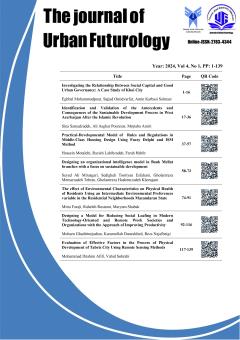-
-
List of Articles
-
Open Access Article
1 - Investigating the Relationship Between Social Capital and Good Urban Governance: A Case Study of Khoi City
Eghbal Mohammadpour Sajjad Omidvarfar Amin Karbasi Salmasi -
Open Access Article
2 - Identification and Validation of the Antecedents and Consequences of the Sustainable Development Process in West Azerbaijan After the Islamic Revolution
Sina Samadzadeh Ali Asghar Pourezat Mojtaba Amiry -
Open Access Article
3 - Practical-Developmental Model of Rules and Regulations in Middle-Class Housing Design Using Fuzzy Delphi and ISM Method
Hossein Motalebi Razyie Labibzadhe Farah Habib -
Open Access Article
4 - Designing an organizational intelligence model in Bank Mellat branches with a focus on sustainable development
Seyedali Mirasgari Tootian Sedigeh Gholamreza Memarzadeh Tehran Gholamreza Hashemzadeh Khorsgani -
Open Access Article
5 - The effect of Environmental Characteristics on Physical Health of Residents Using an Intermediate Environmental Preferences variable in the Residential Neighborhoods Mazandaran State
Mitra Faraji Raheleh Rostami Maryam Shabak -
Open Access Article
6 - Designing a Model for Reducing Social Loafing in Modern Technology-Oriented and Remote Work Societies and Organizations with the Approach of Improving Productivity
Karamollah Daneshfard Reza Najafbeigi Mohsen Ghadirinejadian -
Open Access Article
7 - Evaluation of Effective Factors in the Process of Physical Development of Tabriz City Using Remote Sensing Methods
Mohammad Ibrahim Afifi Vahid Sohrabi
-
The rights to this website are owned by the Raimag Press Management System.
Copyright © 2021-2025







